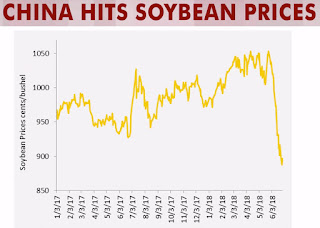President James Polk, a Democrat, might be the forerunner of the president who succeeds Donald Trump. Here's why:
Polk is considered by historians to be the most effective president between George Washington and Abraham Lincoln.
Tariffs played a major role in his success.
Polk is considered by historians to be the most effective president between George Washington and Abraham Lincoln.
Tariffs played a major role in his success.
The Whigs in the 1840s-- like President Trump-- were deeply upset by what they perceived as unfair trading
laws, especially the U.K.’s Corn Tariff.
The Whigs had a good point—but their retaliatory tariff overreacted and set off a crippling trade war.
The Whigs had a good point—but their retaliatory tariff overreacted and set off a crippling trade war.
The Whigs enacted the Tariff
of 1842, known as the Black Tariff because of its dire effects.
In a now-familiar story, the tariff rates doubled overnight.
The new tariffs undid the 1833 trade deal called the Compromise Tariff of 1833. The 1833 law gradually lowered tariffs and promoted economic growth in America.
In a now-familiar story, the tariff rates doubled overnight.
The new tariffs undid the 1833 trade deal called the Compromise Tariff of 1833. The 1833 law gradually lowered tariffs and promoted economic growth in America.
As the 1833 tariff level exposed American
businesses to more competition, industrial interests grew angry and agitated for protection.
The Whigs got what they
asked for in 1842.
Average tariff rates nearly doubled from the initial 20% target for 1842 to about 40%. The impact of the Black Tariff of 1842 was immediate: as the cost of imports jumped, there was a sharp decline in international trade in 1843.
Average tariff rates nearly doubled from the initial 20% target for 1842 to about 40%. The impact of the Black Tariff of 1842 was immediate: as the cost of imports jumped, there was a sharp decline in international trade in 1843.
In the following presidential
election, voters dumped the Whigs.
They voted for Polk and the Democrats who promised to unwind the damage done by the Whigs.
They passed the “Walker Tariff,” the nation’s first standardized tariff. The policy allowed for many more imports, except tobacco and alcoholic beverages.
They voted for Polk and the Democrats who promised to unwind the damage done by the Whigs.
They passed the “Walker Tariff,” the nation’s first standardized tariff. The policy allowed for many more imports, except tobacco and alcoholic beverages.
Trade grew substantially, and relations
with Great Britain improved.
The lesson? Protectionist
tariffs are popular in the moment and voters like this. But they pay dearly as
consumers, and as America becomes a trade island. We will see if Trump’s
protectionism and support from his base suffer the same fate of the Black
Tariffs.

No comments:
Post a Comment